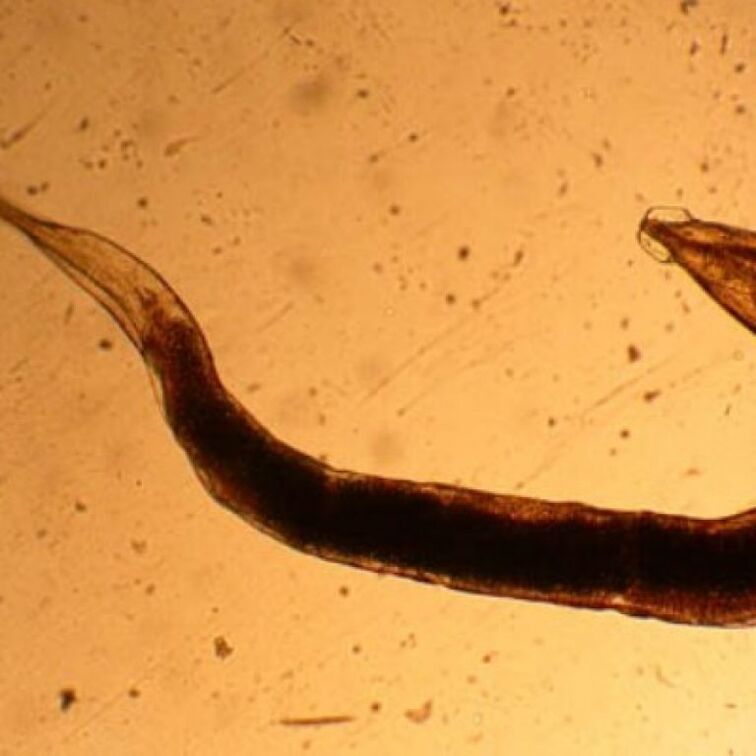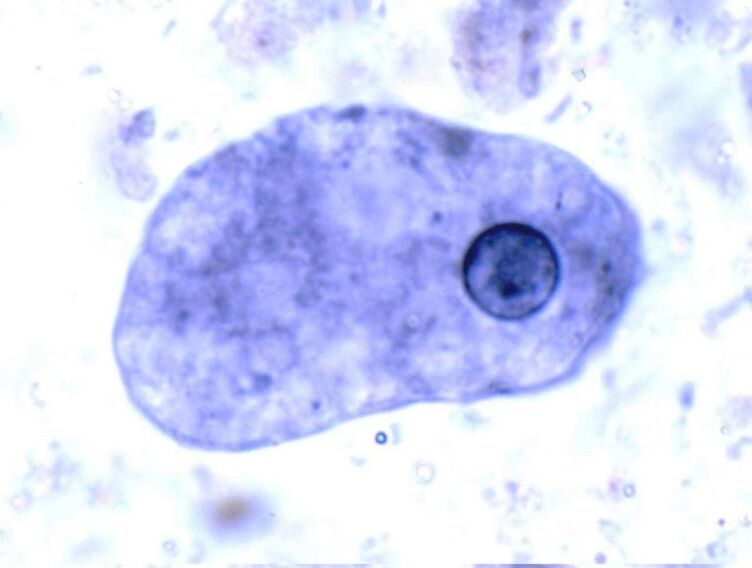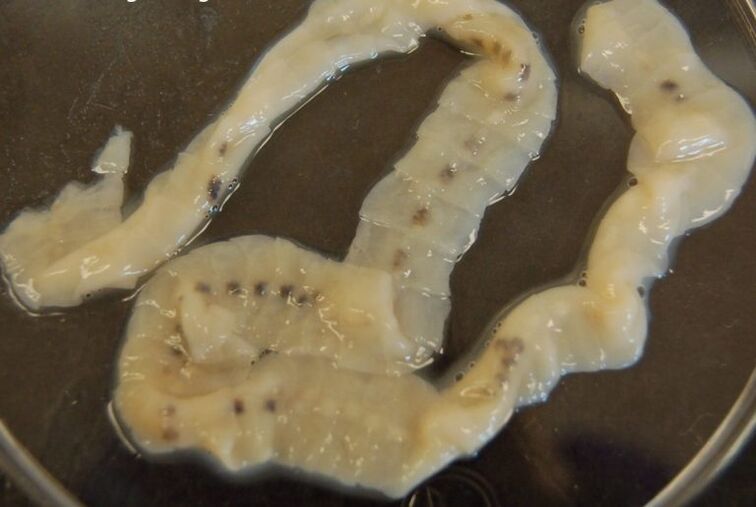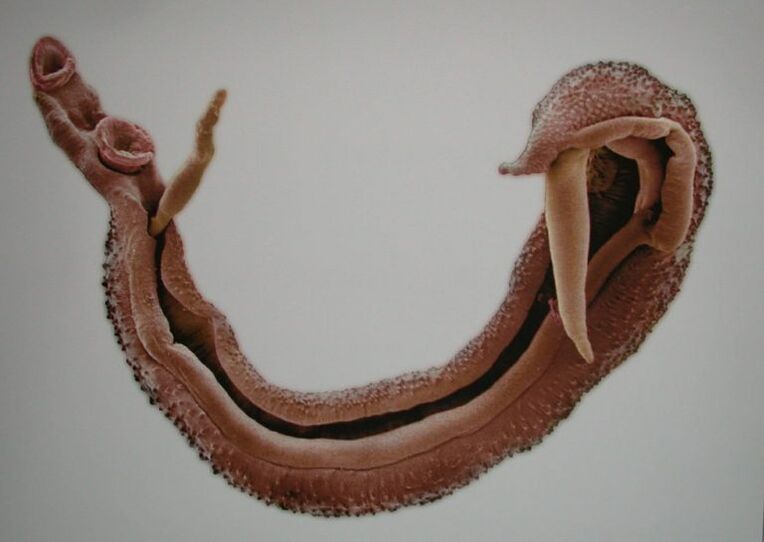For a parasitologist, parasites in the human body are a standard at work. For a normal patient, helminthic invasion is a terrible pathology. The situation is exacerbated by the fact that a person tends to increase the extent of the problem without knowing the enemy by sight. Basic knowledge about the types of parasites that can live in the human body will help defeat fear. And by knowing the problem, you can already competently develop methods of dealing with it, or the principles of protection against it. In the following material we will analyze which worms parasitize in the human body.
Types of worms in the human body
It is important to know that not all real worms can live in the human body. For many, the natural habitat is animal organisms, water or just soil. Below is a list of the most common parasites in the human body with accompanying clinical manifestations.

Pinworm
This is the most common parasite that invades the human body. In addition, humanoid primates can also suffer from enterobiasis. Most often, the pinworm is localized in the body of preschool children. Children from 1 to 10 years are sick.
Pinworm infection occurs when a healthy person comes into contact with an infected person with unwashed hands (shaking hands, touching dirty laundry, towels, etc. ). Pinworm eggs also get into the human body with food.
Important: Insects (flies, cockroaches) can also carry worm eggs.
An adult woman crawls out of the anus at night and lays her eggs in the folds of the skin of the anus, which causes severe itching. In addition, the patient may experience periodic lower abdominal pain when the intensity of the helminth invasion is already high. It is these symptoms of a parasite infection that indicate pinworms in the body. They can be mixed with general fatigue and allergic skin reactions.

Giardia
Protozoa of the genus Flagellate. The localization of such parasites in the human body occurs more often in the small intestine. However, with the flow of blood, protozoa can reach the liver and gallbladder. Parasites enter a person through dirty hands, unwashed vegetables / fruits, or from drinking dirty water.
The symptoms of lamblia parasites are:
- pain in the right hypochondrium;
- stool disorders;
- Excessive fumigation;
- nausea;
- neuroses;
- Allergic manifestations on the skin.
Ascaris
Roundworms in humans, which most often live in the small intestine. At the same time, they can easily migrate to all organs with the blood flow. Often localized in the heart, lungs, liver, and even brain.
An infection with helminth infestation occurs through dirty hands, on which eggs of the parasite from vegetables, fruit, soil, etc. can remain. In this case, the symptoms of the parasites vary depending on the stage of the disease process. So, during the migration of the larva, the following symptoms of parasites are noted in the body:
- Increased body temperature (38 degrees);
- Nocturnal dry cough with shortness of breath;
- Swollen lymph nodes.
If worms are further localized in the human body, the following symptoms occur:
- stool disorder (constipation and diarrhea);
- nerve disorders;
- pneumonia;
- heart failure;
- nausea;
- vomiting;
- Frequent headaches;
- stomach pain.

Histological amoeba
Amoeba is a protozoal parasite. It affects the human body through dirty hands, through the use of dirty foods (vegetables, fruits, herbs) and even through anal intercourse. Flies can also carry amebiosis. Amoeba provokes the formation of ulcers on the walls of the colon and further damage to other organs and systems. In this case, the signs of parasites in the body are as follows:
- stool with blood and mucus;
- pain in the abdomen;
- anemia;
- General weakness and fatigue;
- Formation of abscesses in the organs in which the parasite can be localized.
Toksokara
Round helminth that causes a helminthic invasion called Toxocariasis. In this case, the parasite can be localized in the intestines, in the eyes, in the brain. Toxocar carriers are canines (dogs, wolves, foxes, etc. ). Infection occurs either through contact with a sick animal or through indirect contact with its feces. An infection with parasites of this type brings about different symptoms depending on the organ in which the worm larva has settled. In intestinal toxocariasis, the symptoms are as follows:
- nausea and vomiting;
- diarrhea and constipation;
- pain in the abdomen.
With eye toxocariosis, the patient shows the following signs of parasite infestation:
- visual impairment;
- Purulent discharge from the affected eye;
- Formation of boils on the eyelids;
- reddening of the sclera of the eyes;
- retinal detachment.
When Toxocara settles in the brain, the patient has the following signs of the presence of a parasite in the body:
- headache;
- dizziness and fainting;
- Increased intracranial pressure;
- nervousness and hallucinations;
- Decreased eyesight and concentration.
In this case, the clinical picture is often confused with the oncology of the brain.
- In the case of cardiac toxocariosis, the patient develops heart failure, e. B. tachycardia, arrhythmia, valve failure and cardiac pain.
- When Toxocar affects the airways, there are signs of pneumonia or bronchitis and frequent shortness of breath.
- When the worm settles under the skin, the patient will feel itching, movement and redness on the skin at the site of the worm.

Wide ribbon
This helminth lives in the small intestine of its biological host. It gets there through the mouth with contaminated food (fish, fish roe) or with water. The signs of worms in a body of this type are as follows:
- pain in the abdomen;
- nausea;
- Persistent anemia that cannot be corrected with iron supplementation;
- At an advanced stage of the pathology, the patient develops intestinal obstruction due to a large accumulation of parasites.
Pork tapeworm
This helminth lives in the body of farm animals (rabbits, pigs), as well as in the body of dogs and even camels. It enters the human body together with contaminated meat that has undergone insufficient heat treatment. If an adult worm is found in the patient's body, the diagnosis is "teniasis". If the helminth is detected in the larval stage, the diagnosis is "cysticercosis".
Important: A patient with teniasis is dangerous both for himself (absorption of parasite larvae in the brain, in the eyes, in the skeleton) and for others.
The list of symptoms of the parasite in the human body is as follows:
- A sharp decrease in appetite;
- Severe headache;
- pain in the abdomen;
- faint;
- Visual impairment (with ophthalmic teniasis).
Important: The treatment of pork tapeworms is only carried out in a hospital under the supervision of specialists.
.jpg)
Beef tapeworm (tapeworm)
A parasite that lives in a single individual in the human body. It arrives there with infected cow meat. The list of signs of the parasite in the human body looks like this:
- Insuppressible appetite and lack of weight gain;
- Unstable stool;
- pain in the abdomen;
- Severe allergic manifestations;
- nausea.
Important: The parasite releases itself when certain anthelmintics are used. In addition, its maximum length can be about 12 meters.
The Necator and the Hookworm
These round parasites enter the human body either routinely through dirty hands and food or through contact with the ground. The symptoms of the presence of such parasites in the human body are as follows:
- Skin rash on the body in the form of papules and vesicles (pimples with purulent contents);
- Strong dry cough with shortness of breath;
- abdominal pain;
- Persistent anemia;
- diarrhea;
- nausea;
- Critical loss of appetite.

Alveococcus
This parasite belongs to the cestode group. At the same time, it is important to know that helminths are extremely dangerous for humans, since they first create a primary focus of inflammation in the liver, and then their metastases spread to other organs. Human infection occurs through ingestion of helminth oncospheres into the human mouth. Most often this happens when cutting animal carcasses, during hunting, when using herbs and berries that have been collected in the forest and not adequately processed for food, as well as direct contact with pets infected with the invasion. In this case, only a specialist should assess the symptoms and treatment tactics. The clinical picture of a helminthic invasion looks like this:
- nausea and specific belching;
- pain in the right hypochondrium;
- allergy;
- Severe itching of the skin;
- Suppuration of the place where the parasite is localized and the abscess bursts.
Important: The localization of such an invasion is often found in the lungs or in the brain. You just get rid of the parasite right away.
Echinococcus
Canids and cats are carriers of Echinococcus. In this case a person is only an intermediate host for the parasite. The danger of Echinococcus to humans lies in the fact that the helminths seriously affect a person's organs and systems, provoking the formation of cysts in them. The most common people who work with animals and with slaughtered meat are infected with Echinococcus. That is, the parasite can enter the human body when it cuts an animal's carcass, when it eats contaminated meat or water. It is here to know that the signs of the presence of parasites in an adult may not appear for a long time. When the phase of the absence of symptoms ends, the following clinical picture appears:
- Heavy beehives;
- Itchy skin;
- pain in the place of the parasite larva;
- fever and fever (subject to suppuration of cysts).
Gnatostoma
This type of helminth enters the human body with contaminated poultry, fish or frog meat. You can also become infected with worm larvae using dirty water. The presence of such worms in the human body is manifested in the following symptoms:
- Strong dry cough;
- pain in the area of the parasite larva;
- Severe swelling;
- Severe itching of the skin;
- Increased body temperature.
Important: After a week, all symptoms will go away on their own, but will recur regularly for many years. Damage to the eyes and brain by worms is a major threat. This can be fatal.

Schistosom
river worm. It is dangerous because it can enter the human body even through intact skin. Infections occur in dirty water (more common in Africa), when washing clothes in dirty water, or when watering the soil. In the acute stage of the invasion, the following first signs appear:
- Excessively high body temperature (up to 39 degrees and higher);
- Formation of papules on the body;
- Severe itching of the skin.
In the chronic stage, the disease manifests itself in the form of symptoms such as prostatitis, colitis, colpitis, ascites, renal hydronephrosis, etc. Schistosomiasis can be detected by urinalysis.
Trichinella
A round parasite that parasitizes the muscles of the human body in the larval stage and migrates to the small intestine when it is mature. Trichinella is fatal to humans. You can become infected with such an invasion if you eat poorly fried / boiled meat from wild and domestic animals infected with worms. If the reader does not know how to determine the presence of such a parasite in the body, the clinical picture of the pathology will be as follows:
- Vomiting and severe diarrhea;
- pain in the abdomen;
- loss of appetite;
- muscle pain;
- rashes;
- swelling of the eyelids;
- The temperature rises to 40 degrees.
Important: Trichinosis is the only helminthic invasion in the human body that is also treated with corticosteroid drugs.
After you have found out which parasites can live in the human body and how the infection occurs and what the symptoms of a helminth attack are, you can insure yourself and your loved ones against infections. And if you suspect infection with one or another type of parasite, seek special help in good time.
























